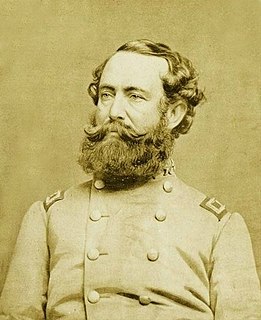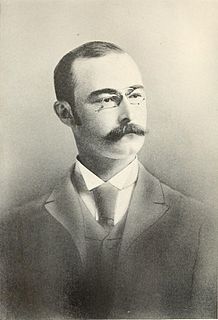Harry Rutledge Elliott Hampton (1897– 1980) was a South Carolina journalist and conservationist who was instrumental in the establishment of Congaree National Park.

South Carolina is a state in the Southeastern United States and the easternmost of the Deep South. It is bordered to the north by North Carolina, to the southeast by the Atlantic Ocean, and to the southwest by Georgia across the Savannah River.

Congaree National Park is a 26,276-acre American national park in central South Carolina. The park received its official designation in 2003 as the culmination of a grassroots campaign that began in 1969. The park preserves the largest tract of old growth bottomland hardwood forest left in the United States. The lush trees growing in its floodplain forest are some of the tallest in the eastern United States, forming one of the highest temperate deciduous forest canopies remaining in the world. The Congaree River flows through the park. About 15,000 acres are designated as a wilderness area.
Hampton was born at the Hampton family home, Woodlands, near Columbia, South Carolina on July 8, 1897. He was the second son of Frank Hampton, Jr. and Gertrude Gonzalez Hampton, and he was a grand-nephew of Confederate General Wade Hampton III. He attended Columbia High School, Randolph-Macon Academy and the University of South Carolina, graduating in 1919. He continued post-graduate study in English at USC in 1920-21. [1]

Woodlands is a historic home located near Columbia, Richland County, South Carolina. It was built in 1896, and is a two-story, wood frame farmhouse with a cross-gable roof and classical and Folk Victorian ornamentation. The front facade features a grand two-tiered porch. Also on the property is a detached kitchen building. Woodlands was the home of Harry R. E. Hampton (1897-1980), a leading journalist and conservationist in South Carolina.

Columbia is the capital and second largest city of the U.S. state of South Carolina, with a population estimate of 134,309 as of 2016. The city serves as the county seat of Richland County, and a portion of the city extends into neighboring Lexington County. It is the center of the Columbia metropolitan statistical area, which had a population of 767,598 as of the 2010 United States Census, growing to 817,488 by July 1, 2016, according to 2015 U.S. Census estimates. The name Columbia is a poetic term used for the United States, originating from the name of Christopher Columbus.

Wade Hampton III was a Confederate States of America military officer during the American Civil War and politician from South Carolina. He came from a wealthy planter family, and shortly before the war he was one of the largest slaveholders in the Southeast as well as a state legislator. During the American Civil War, he served in the Confederate cavalry, where he reached the rank of lieutenant general.
Hampton became a reporter at The State (newspaper) in Columbia. The State was founded by his mother's brothers Narciso Gener, Ambrose E. and William E. Gonzales. Hampton served in a number of capacities, eventually becoming co-editor. An avid hunter, Hampton was interested in conservation issues. Between 1930 and 1964 Hampton wrote his Woods and Water column, emphasizing outdoors and conservation topics, as well as a Sunday column titled The State's Survey. In 1931 he organized a fish and game association that evolved into the South Carolina Wildlife Federation (SCWF), of which Hampton was president. Hampton and the SCWF supported the legislation that established South Carolina's state wildlife resource agencies in 1952. Hampton 's work was described as "the first major effort in South Carolina to bring collective action to the ideal of conservation." [1] [2]

The State is an American daily newspaper published in Columbia, South Carolina. The newspaper is owned and distributed by The McClatchy Company in the Midlands region of the state. It is, by circulation, the second-largest newspaper in South Carolina. after The Post and Courier.

Narciso Gener Gonzales was born in Eddingsville, Edisto Island, South Carolina. He and his brother, Ambrose E. Gonzales, were the founders of The State newspaper in the state capital, Columbia.
Ambrose Elliott Gonzales was born on a plantation in Colleton County, South Carolina. Gonzales was the son of Colonel Ambrosio José Gonzales and Harriet Rutledge Elliot. His father was a Colonel in the Confederate Army who played an instrumental role in the defenses of South Carolina during the American Civil War. Prior to this his father was a Cuban revolutionary leader who opposed oppressive Spanish rule. His mother was the daughter of the wealthy South Carolina rice planter, state senator and writer, William Elliott.
Beginning in the 1950s Hampton promoted the preservation of the Beidler Tract, an area of floodplain forest on the Congaree River that contained some of the tallest trees in the eastern United States. In 1976 the tract was designated Congaree Swamp National Monument by Congress. It became Congaree National Park in 2003. The park's Harry Hampton Visitor Center was named in Hampton's honor. [2] [3]

The Congaree River is a short but wide river in South Carolina in the United States; It flows for approximately 53 miles (85 km). The river serves an important role as the final outlet channel for the entire Lower Saluda and Lower Broad watersheds, before merging with the Wateree River just north of Lake Marion to form the Santee River.
Hampton died on November 16, 1980. He is buried at Trinity Episcopal Cathedral in Columbia, having lived his entire life at Woodlands. The Harry Hampton Memorial Wildlife Fund was established to memorialize Hampton and to endow scholarships in Hampton's name, as well as funding and organizing conservation projects in South Carolina. [1] [4]

Trinity Episcopal Church, now known as Trinity Episcopal Cathedral, is the first Episcopal and the oldest surviving sanctuary in Columbia, South Carolina. It is a Gothic Revival church that is modeled after York Minster in York, England. It was named to the National Register of Historic Places on February 24, 1971.









